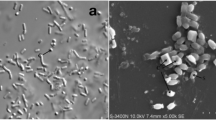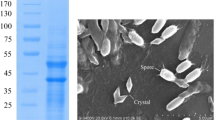Abstract
Photorhabdus akhurstii is an insect–parasitic bacterium that symbiotically associates with the nematode, Heterorhabditis indica. The bacterium possesses several pathogenicity islands that aids in conferring toxicity to different insects. Herein, we constructed the plasmid clones of coding sequences of four toxin genes (pirA, tcaA, tccA and tccC; each was isolated from four P. akhurstii strains IARI-SGMG3, IARI-SGGJ2, IARI-SGHR2 and IARI-SGMS1) in Escherichia coli and subsequently, their biological activity were investigated against the fourth-instar larvae of the model insect, Galleria mellonella via intra-hemocoel injection. Bioinformatics analyses indicated inter-strain amino acid sequence difference at several positions of the candidate toxins. In corroboration, differential insecticidal activity of the identical toxin protein (PirA, TcaA, TccA and TccC conferred 15–59, 27–100, 25–100 and 33–98% insect mortality, respectively, across the strains) derived from the different bacterial strains was observed, suggesting that the diverse gene pool in Indian strains of P. akhurstii leads to strain-specific virulence in this bacterium. These toxin candidates appear to be an attractive option to deploy them in biopesticide development for managing the insect pests globally.










Similar content being viewed by others
References
Aloy P, Russell RB (2003) Interprets: protein interaction prediction through tertiary structure. Bioinformatics 19:161–162
Blackburn M, Golubeva E, Bowenffrench-Constant DRH (1998) A novel insecticidal toxin from Photorhabdus luminescens, Toxin complex a (Tca), and its histopathological effects on the midgut of Manduca sexta. Appl Environ Microbiol 64:3036–3041
Boemare N (2002) Interactions between the partners of the entomopathogenic bacterium nematode complexes, Steinernema-Xenorhabdus and Heterorhabditis-Photorhabdus. Nematology 4:601–603
Bowen D, Rocheleau TA, Blackburn M, Andreev O, Golubeva E, Bhartiaffrench-Constant RRH (1998) Insecticidal toxins from the bacterium Photorhabdus luminescens. Science 280:2129–2132
Brown SE, Cao AT, Dobson P, Hines ER, Akhurst RJ (2006) East PD (2006) Txp40, a ubiquitous insecticidal toxin protein from Xenorhabdus and Photorhabdus bacteria. Appl Environ Microbiol 72:1653–1662
Carrière Y, Brown ZS, Downes SJ, Gujar G, Epstein G, Omoto C et al (2019) Governing evolution: a socioecological comparison of resistance management for insecticidal transgenic Bt crops among four countries. Ambio 49:1–16
Daborn PJ, Waterfield N, Silva CP, Au CPY, Sharma S, ffrench-Constant RH (2002) A single Photorhabdus gene, makes caterpillars floppy (mcf), allows Escherichia coli to persist within and kill insects. Proc Natl Acad Sci USA 99:10742–10747
Dhaliwal GS, Jindal V, Mohindru B (2015) Crop losses due to insect pests: global and Indian scenario. Ind J Entomol 77:165–168
Duchaud E, Rusniok C, Frangeul L, Buchrieser C, Givaudan A, Taourit S et al (2003) The genome sequence of the entomopathogenic bacterium Photorhabdus luminescens. Nat Biotechnol 21:1307–1313
Ebeling W, Hennrich N, Klockow M, Metz H, Orth HD, Lang H (1974) Proteinase K from Tritirachium album Limber. Eur J Biochem 47:91–97
Fand BB, Nagrare VS, Gawande SP, Nagrale DT, Naikwadi BV, Deshmukh V, Gokte-Narkhedkar N, Waghmare VN (2019) Widespread infestation of pink bollworm, Pectinophora gossypiella (Saunders)(Lepidoptera: Gelechidae) on Bt cotton in Central India: a new threat and concerns for cotton production. Phytoparasitica 47:313–325
ffrench-Constant RH, Dowling A, Waterfield NR (2007) Insecticidal toxins from Photorhabdus bacteria and their potential use in agriculture. Toxicon 49:436–451
ffrench-Constant RH, Dowling A (2014) Photorhabdus toxins. In: Dhadialla TS, Gill SS (eds) Advances in insect physiology: insect midgut and insecticidal proteins, 47th edn. Elsevier, San Francisco, pp 343–388
ffrench-Constant RH, Waterfield N, Burland Perna Daborn VNTPJ, Bowen D et al (2000) A genomic sample sequence of the entomopathogenic bacterium Photorhabdus luminescens W14: potential implications for virulence. Appl Environ Microbiol 66:3310–3329
Grewal PS, Ehlers RU, Shapiro-Ilan DI (2005) Critical issues and research needs for expanding the use of nematodes in biocontrol. In: Grewal PS, Ehlers RU, Shapiro-Ilan DI (eds) Nematodes as biocontrol agents. CAB International, Wallingdord, UK, pp 479–528
Henderson B (2010) Integrating the cell stress response: a new view of molecular chaperones as immunological and physiological homeostatic regulators. Cell Biochem Funct 28:1–14
Joshi MC, Sharma A, Kant S, Birah A, Gupta GP, Khan SR et al (2008) An insecticidal GroEL protein with chitin binding activity from Xenorhabdus nematophila. J Biol Chem 283:28287–28296
Kraus E, Kiltz HH, Femfert UF (1976) The specificity of proteinase K against oxidized insulin B chain. Hoppe Seylers Z Physiol Chem 357:233–237
Kumar R, Kushwah J, Ganguly S, Garg V, Somvanshi VS (2016) Proteomic investigation of Photorhabdus bacteria for nematode–host specificity. Indian J Microbiol 56:361–367
Kushwah J, Kumar P, Garg V, Somvanshi VS (2017) Discovery of a highly virulent strain of Photorhabdus luminescens ssp. akhurstii from Meghalaya. India Indian J Microbiol 57:125–128
Lacey LA, Georgis R (2012) Entomopathogenic nematodes for control of insect pests above and below ground with comments on commercial production. J Nematol 44:218–225
Li M, Wu G, Liu C, Chen Y, Qiu L, Pang Y (2009) Expression and activity of a probable toxin from Photorhabdus luminescens. Mol Biol Rep 36:785–790
Machado RAR, Wüthrich D, Kuhnert P, Arce CCM, Thönen L, Ruiz C et al (2018) Whole-genome-based revisit of Photorhabdus phylogeny: proposal for the elevation of most Photorhabdus subspecies to the species level and description of one novel species Photorhabdus bodei sp. nov., and one novel subspecies Photorhabdus laumondii subsp. clarkei subsp. nov. Int J Syst Evol Microbiol 68:2664–2681
Mathur C, Kushwah J, Somvanshi VS, Dutta TK (2018) A 37 kDa Txp40 protein characterized from Photorhabdus luminescens sub sp. akhurstii conferred injectable and oral toxicity to greater wax moth Galleria mellonella. Toxicon 154:69–73
Mathur C, Phani V, Kushwah J, Somvanshi VS, Dutta TK (2019) TcaB, an insecticidal protein from Photorhabdus akhurstii causes cytotoxicity in the greater wax moth, Galleria mellonella. Pestic Biochem Physiol 157:219–229
McMullen JG, Stock SP (2014) In vivo and in vitro rearing of entomopathogenic nematodes (Steinernematidae and Heterorhabditidae). J Vis Exp 91:52096
Mohan KS, Ravi KC, Suresh PJ, Sumerford D, Head GP (2016) Field resistance to the Bacillus thuringiensis protein Cry1Ac expressed in Bollgard® hybrid cotton in pink bollworm, Pectinophora gossypiella (Saunders), populations in India. Pest Manag Sci 72:738–746
Morgan JA, Sergeant M, Ellis D, Ousley M, Jarrett P (2001) Sequence analysis of insecticidal genes from Xenorhabdus nematophilus PMFI296. Appl Environ Microbiol 67:2062–2069
Naik VC, Kumbhare S, Kranthi S, Satija U, Kranthi KR (2018) Field-evolved resistance of pink bollworm, Pectinophora gossypiella (Saunders)(Lepidoptera: Gelechiidae), to transgenic Bacillus thuringiensis (Bt) cotton expressing crystal 1Ac (Cry1Ac) and Cry2Ab in India. Pest Manag Sci 74:2544–2554
Nair R, Kamath SP, Mohan KS, Head G, Sumerford DV (2016) Inheritance of field-relevant resistance to the Bacillus thuringiensis protein Cry1Ac in Pectinophora gossypiella (Lepidoptera: Gelechiidae) collected from India. Pest Manag Sci 72:558–565
Rathee M, Dalal P (2018) Emerging insect pests in Indian agriculture. Ind J Entomol 80:267–281
Shankhu PY, Mathur C, Mandal A, Sagar D, Somvanshi VS, Dutta TK (2020) Txp40, a protein from Photorhabdus akhurstii conferred potent insecticidal activity against the larvae of Helicoverpa armigera, Spodoptera litura and S. exigua. Pest Manag Sci 76:2004–2014. https://doi.org/10.1002/ps.5732
Sheets J, Aktories K (2017) Insecticidal toxin complexes from Photorhabdus luminescens. In: ffrench-Constant RH (ed) The molecular biology of Photorhabdus bacteria. Springer, Cham, pp 3–24
Somvanshi VS, Dubay B, Kushwah J, Ramamoorthy S, Vishnu US, Sankarasubramanian J et al (2019) Draft genome sequences for five Photorhabdus bacterial symbionts of entomopathogenic Heterorhabditis nematodes isolated from India. Microbiol Resour Announc 8:e01404–e1418
Ullah I, Jang EK, Kim MS, Shin JH, Park GS, Khan A et al (2014) Identification and characterization of the insecticidal toxin “makes caterpillars floppy” in Photorhabdus temperata M1021 using a cosmid library. Toxins 6:2024–2040
Vlisidou I, Hapeshi A, Healey JR, Smart K, Yang G, Waterfield NR (2019) The Photorhabdus asymbiotica virulence cassettes deliver protein effectors directly into target eukaryotic cells. ELife 8:e46259
Waterfield N, Kamita SG, Hammock BD, Ffrench-Constant R (2005) The Photorhabdus Pir toxins are similar to a developmentally regulated insect protein but show no juvenile hormone esterase activity. FEMS Microbiol Lett 245:47–52
Waterfield NR, Sanchez-Contreras M, Eleftherianos I, Dowling A, Yang G, Wilkinson P et al (2008) Rapid Virulence Annotation (RVA): identification of virulence factors using a bacterial genome library and multiple invertebrate hosts. Proc Natl Acad Sci USA 105:15967–15972
Webster JM, Chen G, Hu K, Li J (2002) Bacterial metabolites. In: Gaugler R (ed) Entomopathogenic nematology. CABI Publishing, Oxon, New York, pp 99–114
Wilkinson P, Waterfield NR, Crossman L, Corton C, Sanchez-Contreras M, Vlisidou I et al (2009) Comparative genomics of the emerging human pathogen Photorhabdus asymbiotica with the insect pathogen Photorhabdus luminescens. BMC Genomics 10:1–22
Yang J, Zeng HM, Lin HF, Yang XF, Liu Z, Guo LH, Yuan JJ, Qiu DW (2012) An insecticidal protein from Xenorhabdus budapestensis that results in prophenoloxidase activation in the wax moth, Galleria mellonella. J Invertebr Pathol 110:60–67
Yao Q, Cui J, Zhu Y, Wang G, Hu L, Long C et al (2009) A bacterial type III effector family uses the papain-like hydrolytic activity to arrest the host cell cycle. Proc Natl Acad Sci USA 106:3716–3721
Zhang X, Hu X, Li Y, Ding X, Yang Q, Sun Y, Yu Z, Xia L, Hu S (2014) XaxAB-like binary toxin from Photorhabdus luminescens exhibits both insecticidal activity and cytotoxicity. FEMS Microbiol Lett 350:48–56
Funding
This study was supported by Science and Engineering Research Board (Grant Number YSS/2014/000452).
Author information
Authors and Affiliations
Corresponding author
Electronic supplementary material
Below is the link to the electronic supplementary material.
13205_2020_2288_MOESM1_ESM.pdf
Supplementary file1 Table S1. List of oligonucleotides employed for cloning and sequencing of Photorhabdus toxin genes. Annealing temperature for each PCR reaction was 60°C.Figure S1. Agarose gel photographs showing the PCR amplified fragments of toxin genes, such as pirA (417 bp), tcaA (3288 bp), tccA (2898 bp) and tccC (3132 bp) from the genomic DNA of P. akhurstii strains IARI-SGMG3, IARI-SGGJ2, IARI-SGHR2 and IARI-SGMS1.Figure S2. SDS-PAGE analysis of P. akhurstii (IARI-SGMG3) toxins induced by 1 mM IPTG for 4 h in E. coli BL21 cells. Lanes: M—protein molecular weight marker, 1—uninduced BL21 cells harboring TcaA, 2—induced BL21 cells harboring TcaA, 3—uninduced BL21 cells harboring TccC, 4—induced BL21 cells harboring TccC, 5—uninduced BL21 cells harboring TccA, 6—induced BL21 cells harboring TccA, 7—uninduced BL21 cells harboring PirA, 8—induced BL21 cells harboring PirA. Arrows indicate the overexpression of target protein. The calculated molecular mass (using Expasy ProtParam tool; https://web.expasy.org/protparam/) of TcaA, TccC, TccA and PirA was 120, 111, 105 and 15 kDa, respectively. (PDF 366 kb)
Rights and permissions
About this article
Cite this article
Dutta, T.K., Mathur, C., Mandal, A. et al. The differential strain virulence of the candidate toxins of Photorhabdus akhurstii can be correlated with their inter-strain gene sequence diversity. 3 Biotech 10, 299 (2020). https://doi.org/10.1007/s13205-020-02288-0
Received:
Accepted:
Published:
DOI: https://doi.org/10.1007/s13205-020-02288-0




